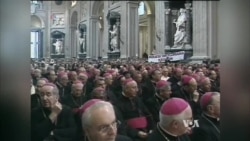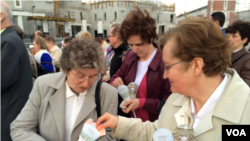On April 27, two popes - John the XXIII and John Paul II - will be made saints in a ceremony at St. Peter’s Square. The dual canonization is part of the current pope’s program to reconcile liberals and conservatives in the Roman Catholic Church.
“Saint Now!” has been the chant of Pope John Paul II’s impatient fans since his death in 2005. Only six years later the healing of an ailing Costa Rican woman was credited as his second required miracle.
According to Jesuit priest and Vatican watcher Thomas Reese, Pope Francis was then asked by the people in charge of the canonization when he wanted to schedule it.
“And Pope Francis’ response was, 'well what about John XXIII?' And they said, 'well, he’s only got one miracle, and he needs two miracles in order to become a saint, in order to be canonized'," Reese recalled. "And his response was, 'Says who? He’s the Pope!' ”
John Paul II is certainly the better known of the two. The Polish pope journeyed to the far corners of the earth and his papacy is often believed to have accelerated the fall of Communism.
John XXIII only became pope in 1958 because the cardinals couldn't decide whom they wanted, says Reese.
“He was an old man," explained Reese. "They elected him as kind of a placesitter.”
But he convened the Second Vatican Council to modernize a seemingly anachronistic institution.
“This was an extraordinary move because we hadn’t had an ecumenical council like this in a long, long time,” Reese noted.
The council decided Mass no longer had to be in Latin and opened a dialogue with other faiths. Some traditionalists feel John XXIII and the council went too far, while some liberals feel John Paul II was dogmatic and covered up clerical sex abuse. Francis wants to reconcile these groups, Reese explained.
“So this is a symbolic way for him to say we’re all one family," he said. "We’re all united by Jesus Christ, and we can all come together to celebrate both of these men.”
The two popes are both examples for clergy today, according to Rev. Richard de Lillio, a professor of homiletics at Catholic University of America in Washington.
“I think what they had that every preacher should have is dynamism," Lillio said, "and the second thing they had that every preacher should have is they preached what they believed and witnessed it."
Fans of Francis say that also describes the current pope.
“Saint Now!” has been the chant of Pope John Paul II’s impatient fans since his death in 2005. Only six years later the healing of an ailing Costa Rican woman was credited as his second required miracle.
According to Jesuit priest and Vatican watcher Thomas Reese, Pope Francis was then asked by the people in charge of the canonization when he wanted to schedule it.
“And Pope Francis’ response was, 'well what about John XXIII?' And they said, 'well, he’s only got one miracle, and he needs two miracles in order to become a saint, in order to be canonized'," Reese recalled. "And his response was, 'Says who? He’s the Pope!' ”
John Paul II is certainly the better known of the two. The Polish pope journeyed to the far corners of the earth and his papacy is often believed to have accelerated the fall of Communism.
John XXIII only became pope in 1958 because the cardinals couldn't decide whom they wanted, says Reese.
“He was an old man," explained Reese. "They elected him as kind of a placesitter.”
But he convened the Second Vatican Council to modernize a seemingly anachronistic institution.
“This was an extraordinary move because we hadn’t had an ecumenical council like this in a long, long time,” Reese noted.
The council decided Mass no longer had to be in Latin and opened a dialogue with other faiths. Some traditionalists feel John XXIII and the council went too far, while some liberals feel John Paul II was dogmatic and covered up clerical sex abuse. Francis wants to reconcile these groups, Reese explained.
“So this is a symbolic way for him to say we’re all one family," he said. "We’re all united by Jesus Christ, and we can all come together to celebrate both of these men.”
The two popes are both examples for clergy today, according to Rev. Richard de Lillio, a professor of homiletics at Catholic University of America in Washington.
“I think what they had that every preacher should have is dynamism," Lillio said, "and the second thing they had that every preacher should have is they preached what they believed and witnessed it."
Fans of Francis say that also describes the current pope.









